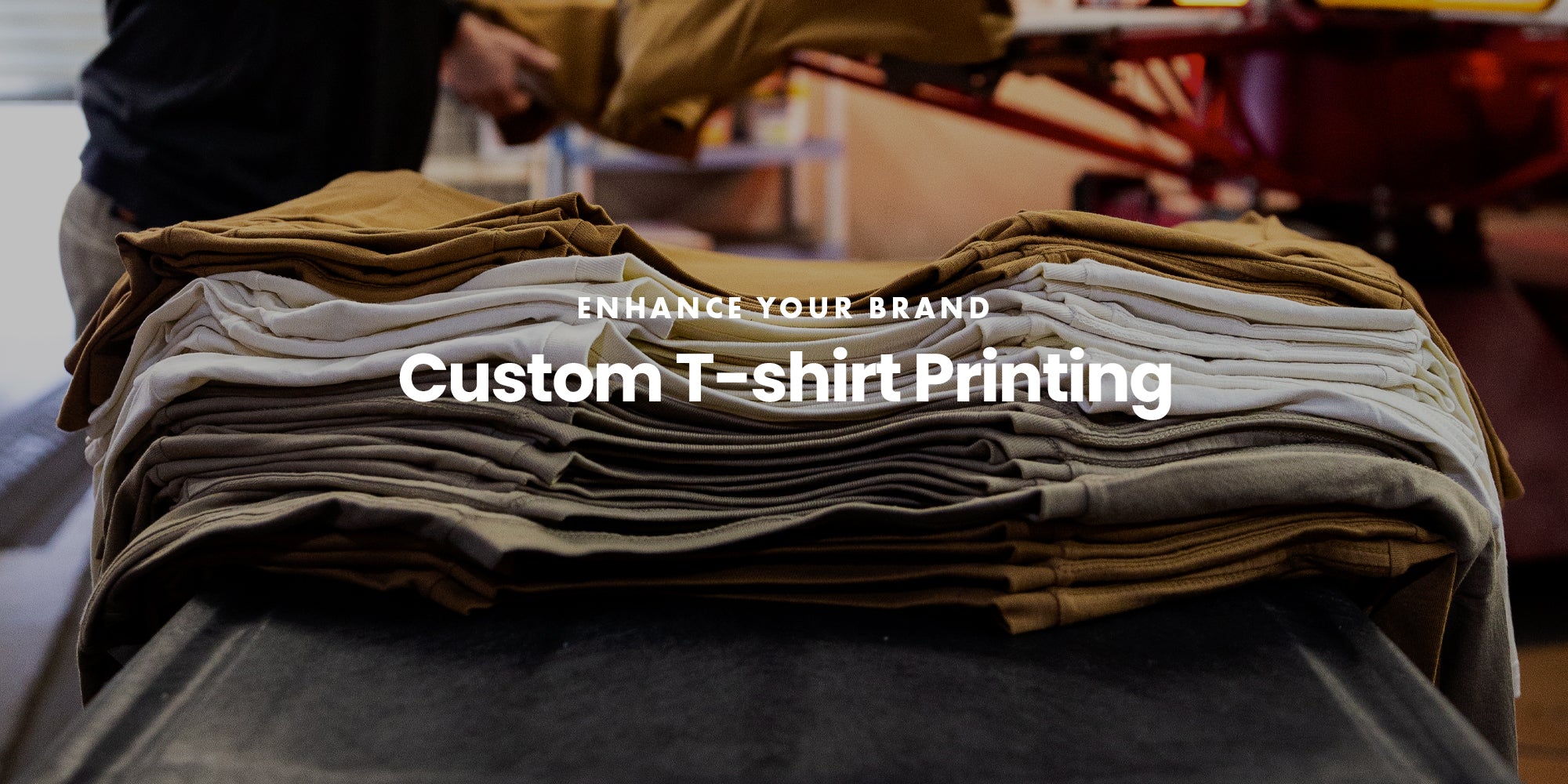Fast Turnaround Custom Screen Printing for Events
Fast Turnaround Custom Screen Printing for Events
Blog Article
Screen Printing Uncovered: Whatever You Required to Find Out About Tee Shirt and Garment Printing Strategies
If you've ever before wondered how those lively designs wind up on your preferred tee shirts, you're in the appropriate area. Screen printing is a remarkable technique that combines art with method, using endless possibilities for creativity. Understanding the fundamentals, from tools to ink selections, can significantly affect your outcomes. Prepared to discover the important aspects that make screen printing an art kind? Allow's discover the information that can elevate your tasks.
The Basics of Screen Printing: How It Functions
When you plunge right into display printing, you'll find it's both a science and an art. At its core, display printing includes creating a pattern, or display, that permits ink to pass via just in particular locations.
Placement the screen over the fabric, after that make use of a squeegee to press ink via the screen onto the garment. Each action is crucial, and grasping them will certainly raise your screen printing abilities, transforming basic garments into unique, expressive items.
Sorts Of Screen Printing Techniques
When you understand the basics of display printing, it's time to discover the various techniques that can boost your designs. One prominent approach is standard screen printing, where ink is pushed through a stenciled screen. This method is great for vibrant, vivid shades. Then there's water-based ink printing, which uses a softer feel and is environment-friendly, but it needs a different strategy to treating.
One more option is plastisol printing, known for its resilience and brilliant colors, making it a favored for lots of brands. Experiment with halftone printing to create gradient impacts and elaborate layouts.
Crucial Tools for Screen Printing
To achieve magnificent lead to screen printing, having the best devices is essential. First, you'll require a strong screen printing frame, which holds the mesh that transfers your design onto the garment. Next, buy top quality mops; these are important for applying ink equally across the display. You'll additionally require an excellent exposure unit to create your displays, as well as a washout booth for cleansing them after usage. A dependable warm resource, like a conveyor dryer or heat press, is vital for healing your prints to guarantee long life. Do not fail to remember a proper work space, outfitted with tables and storage for your materials. Lastly, safety gear, such as masks and handwear covers, will certainly keep you secure from chemicals and inks. With the right devices, you'll be well on your way to creating professional-quality prints.
Choosing the Right Inks and Products
When choosing inks and materials for display printing, you require to take into consideration the sort of ink that functions finest for your project. Think about material compatibility to ensure your styles look last and terrific lengthy. Discover green ink alternatives to make your printing process much more sustainable.
Sorts Of Screen Inks
Choosing the appropriate screen ink is crucial for accomplishing dynamic, resilient prints that satisfy your job's needs. There are several types of display inks to check out. Plastisol ink is prominent for its flexibility and convenience of usage, giving exceptional shade opacity on dark materials. Water-based ink, on the other hand, provides a softer feel and is environment-friendly, making it optimal for those seeking to minimize their ecological impact. Discharge inks remove dye from the material, leading to a soft, classic appearance however require specific handling. Ultimately, specialized inks, such as glow-in-the-dark or metal, can add one-of-a-kind effects to your designs. Review your task needs and pick the ink that straightens best with your desired end result.

Textile Compatibility Factors To Consider
Recognizing fabric compatibility is crucial for accomplishing high-grade display prints, especially because different products respond distinctly to various inks. When selecting inks, take into consideration the fabric type-- cotton, polyester, or blends. For cotton, water-based inks function well, offering softness and breathability. Polyester, on the various other hand, usually needs plastisol inks for much better attachment and vivid colors. If you're printing on blends, you could need to make use of a mix of both kinds. Always examine your inks on sample fabric to ensure they adhere appropriately and keep color honesty. In addition, maintain in mind that material weight and structure can influence the last outcome, so picking the best ink and material combo is essential for your task's success.
Eco-Friendly Ink Options
Green inks are becoming a prominent choice for screen printers who desire to decrease their environmental impact while maintaining quality. When picking inks, consider water-based inks, which are less hazardous and much easier to clean up contrasted to traditional solvents.
Additionally, seek inks made from sustainable resources, such as soy or vegetable-based alternatives. By picking the ideal inks and materials, you'll not just create sensational designs but also contribute to a more lasting printing procedure. Make the button, and your prints will certainly reflect your dedication to the setting!
Preparing Your Layout for Display Printing

File Format Demands
To guarantee your design looks lively and sharp on textile, you'll need to pay close interest to submit style requirements for screen printing. Make certain your style has a clear history to prevent undesirable white edges on your prints. Keep shade modes in mind; CMYK is conventional for screen printing, so transform your RGB makes accordingly.
Shade Splitting Up Techniques
Color separation is an essential step in preparing your style for screen printing, and mastering it can considerably improve your print high quality. anchor You'll require to damage your layout right into specific shades, as each color calls for a separate screen during printing. Begin by recognizing all the colors in your layout and produce layers each. You can make use of software program like Adobe Photoshop or Illustrator to separate and separate colors efficiently. Be certain to conserve each layer as a different documents, generally in a format like TIFF or PSD. This precision not just guarantees precise color representation but also streamlines the printing procedure. By taking note of shade separation, you'll attain professional and dynamic results in your screen-printed garments.
Resolution and Size
Attaining the ideal outcomes in screen printing starts with guaranteeing your style has the appropriate resolution and dimension. Preferably, your art work ought to be at least 300 DPI (dots per inch) for sharp, clear prints. Your final item may look amateur and pixelated. if you utilize lower resolution.
When it pertains to size, take into consideration the dimensions of your print area. Design your art work to match the last print size, ideally producing it in the real measurements you'll be printing. By doing this, you'll stay clear of any unforeseen scaling problems.
Always examine your style in both vector and raster layouts. Vector graphics can be scaled without losing quality, making them ideal for display printing. Preparing appropriately will assure your design looks impressive on every garment!
Step-by-Step Screen Printing Refine
Screen printing is a dynamic procedure that enables you to develop dynamic layouts on various surfaces. To get begun, you'll need a display, emulsion, and your picked ink.
Pour ink onto the screen and use a squeegee to press the ink via the stencil onto the textile. Lift the screen meticulously and allow the print dry. You've effectively screen published your layout.
Tips for Effective Screen Printing Projects
While you're diving right into your screen printing tasks, bear in mind that preparation is key to success. look at this website Begin by gathering all your products-- inks, displays, garments, and squeegees. A tidy office assists avoid undesirable mistakes, so clean up prior to you begin.
Next, validate your art work is high-resolution and appropriately sized for your garment. Test your display for correct exposure and tidy it extensively to avoid spots. When mixing your inks, follow the supplier's standards to achieve the right consistency.
Throughout printing, use even pressure with your squeegee for regular results. Don't hurry; take your time to verify each print fulfills your standards. After printing, allow your garments dry entirely before handling or packaging them.
Finally, always keep an example of your job for future referral. This means, you can examine your progress and boost your methods with time. Satisfied printing!

Frequently Asked Concerns
How Lengthy Does It Require To Establish a Display Printing Work?
Establishing a display printing job usually takes around 30 minutes to an hour. You'll prepare the displays, mix inks, and change journalism. The time varies based upon complexity and experience, so stay organized!
Can I Publish on Different Textile Keys In Making Use Of the Exact Same Technique?
Yes, you can publish on different textile types using the exact same strategy, but you'll require to adjust your settings and inks. Some textiles absorb ink in a different way, so trying out warranties the most effective outcomes for every product.
What Prevail Errors to Avoid in Screen Printing?
When display printing, avoid usual errors like making use of the wrong ink, disregarding correct exposure times, or avoiding pre-press checks. Constantly check your configuration and maintain clean displays to assure high quality outcomes each time.
Just How Can I Properly Clean and Preserve My Display Printing Equipment?
To correctly tidy and preserve image source your display printing tools, you should frequently wash screens with appropriate solvents, inspect mops for wear, and ensure all tools are kept dust-free and dry. Uniformity boosts and prevents pricey repairs efficiency.
Is Screen Printing Ecologically Pleasant Compared to Various Other Techniques?
Display printing can be extra eco-friendly than other techniques, specifically if you use eco-conscious products and water-based inks. By choosing sustainable materials and methods, you minimize waste and decrease your influence on the planet.
Screen Printing Uncovered: Whatever You Need to Know Concerning Tee and Garment Printing Techniques
At its core, screen printing includes creating a pattern, or screen, that enables ink to pass through just in details locations. Position the screen over the fabric, then utilize a squeegee to press ink with the screen onto the garment. One popular method is conventional display printing, where ink is pressed with a stenciled screen.When picking inks and materials for display printing, you need to take right into account the kind of ink that works ideal for your project.
Report this page